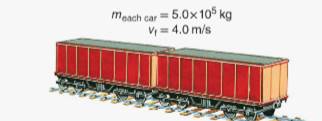
Concept explainers
(a)
The momentum of first railroad car before collision.
(a)
Answer to Problem 67A
Explanation of Solution
Given:
Mass of each railroad car
Initially the railroad car
Initial velocity of the railroad car

Formula used:
Momentum
The momentum of first railroad car before collision can be calculated using the equation,
Calculation:
Substituting the numerical values in equation
Conclusion:
The momentum of first railroad car before collision is
(b)
Total momentum of the two cars after collision.
(b)
Answer to Problem 67A
Explanation of Solution
Given:
Mass of each railroad car
Mass of each railroad car
Final velocity of the cars is
Formula used:
Total momentum of the two cars after collision can be calculated using the equation,
Calculation:
After collision, the two cars lock together. Hence, the total mass of the cars is
Substituting the numerical values in equation
Conclusion:
Total momentum of the two cars after collision is
(c)
The kinetic energies of the two cars before and after the collision.
(c)
Answer to Problem 67A
Explanation of Solution
Given:
Mass of each railroad car
Mass of each railroad car
Initial velocity of the railroad car
Initial velocity of the railroad car
Final velocity of the cars is
Formula used:
Kinetic energy
Kinetic energy of the railroad car
Kinetic energy of the railroad car
Kinetic energy of the railroad cars after the collision can be calculated using the equation,
Calculation:
After the collision the two cars lock together, hence the total mass of the cars is
Kinetic energy of the railroad car
Kinetic energy of the railroad car
Kinetic energy of the railroad cars after the collision can be calculated by substituting the numerical values in equation
Conclusion:
Kinetic energy of the railroad car
Kinetic energy of the railroad car
Kinetic energy of the railroad cars after the collision is
(d)
To explain: The change of kinetic energy.
(d)
Answer to Problem 67A
The loss in kinetic energy during the collision is converted in to the thermal energy and sound energy.
Explanation of Solution
Given:
Mass of each railroad car
Mass of each railroad car
Initial velocity of the railroad car
Initial velocity of the railroad car
Final velocity of the cars is
Formula used:
Kinetic energy
The momentum of the body is conserved during the collision but the kinetic energy of the body is not conserved during the collision.
As calculated in the part (c), the kinetic energy of the railroad cars before collision is
Therefore, the loss in kinetic energy during the collision is,
The loss in kinetic energy during the collision is converted in to the thermal energy and sound energy.
Chapter 11 Solutions
Glencoe Physics: Principles and Problems, Student Edition
Additional Science Textbook Solutions
College Physics (10th Edition)
College Physics
College Physics: A Strategic Approach (3rd Edition)
Essential University Physics: Volume 2 (3rd Edition)
Physics: Principles with Applications
Sears And Zemansky's University Physics With Modern Physics
 College PhysicsPhysicsISBN:9781305952300Author:Raymond A. Serway, Chris VuillePublisher:Cengage Learning
College PhysicsPhysicsISBN:9781305952300Author:Raymond A. Serway, Chris VuillePublisher:Cengage Learning University Physics (14th Edition)PhysicsISBN:9780133969290Author:Hugh D. Young, Roger A. FreedmanPublisher:PEARSON
University Physics (14th Edition)PhysicsISBN:9780133969290Author:Hugh D. Young, Roger A. FreedmanPublisher:PEARSON Introduction To Quantum MechanicsPhysicsISBN:9781107189638Author:Griffiths, David J., Schroeter, Darrell F.Publisher:Cambridge University Press
Introduction To Quantum MechanicsPhysicsISBN:9781107189638Author:Griffiths, David J., Schroeter, Darrell F.Publisher:Cambridge University Press Physics for Scientists and EngineersPhysicsISBN:9781337553278Author:Raymond A. Serway, John W. JewettPublisher:Cengage Learning
Physics for Scientists and EngineersPhysicsISBN:9781337553278Author:Raymond A. Serway, John W. JewettPublisher:Cengage Learning Lecture- Tutorials for Introductory AstronomyPhysicsISBN:9780321820464Author:Edward E. Prather, Tim P. Slater, Jeff P. Adams, Gina BrissendenPublisher:Addison-Wesley
Lecture- Tutorials for Introductory AstronomyPhysicsISBN:9780321820464Author:Edward E. Prather, Tim P. Slater, Jeff P. Adams, Gina BrissendenPublisher:Addison-Wesley College Physics: A Strategic Approach (4th Editio...PhysicsISBN:9780134609034Author:Randall D. Knight (Professor Emeritus), Brian Jones, Stuart FieldPublisher:PEARSON
College Physics: A Strategic Approach (4th Editio...PhysicsISBN:9780134609034Author:Randall D. Knight (Professor Emeritus), Brian Jones, Stuart FieldPublisher:PEARSON





